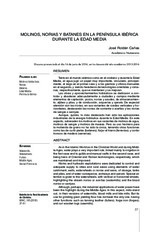Molinos, norias y batanes en la Península Ibérica durante la Edad Media
Autor
Roldán Cañas, José
Editor
Real Academia de Córdoba de Ciencias, Bellas Letras y Nobles ArtesFecha
2016Materia
Molinos hidráulicosNorias
Batanes
Edad Media
Península Ibérica
Watermills
Waterwheels
Fullers
Middle Ages
Iberian Peninsula
METS:
Mostrar el registro METSPREMIS:
Mostrar el registro PREMISMetadatos
Mostrar el registro completo del ítemResumen
Tanto en el mundo islámico como en el cristiano y durante la Edad
Media, el agua jugó un papel muy importante, vinculado, principalmente,
al riego en el primer caso y a los gremios y oficios manuales
en el segundo, y siendo herederos de tecnologías orientales y romanas,
respectivamente, que se mantienen y se mejoran.
Las obras y aprovechamientos hidráulicos se dedicaron a controlar
y abastecer adecuadamente a ciudades y campos mediante
elementos de captación, pozos, norias y azudes, de almacenamiento,
aljibes y pilas, y de conducción, arquerías y qanats. De especial
atención son las norias, en sus variantes de ruedas verticales y horizontales,
destacando las norias de corriente o aceñas y las norias
de sangre o saniyas.
Aunque, quizás, lo más destacado han sido las aplicaciones
industriales de la energía hidráulica durante la Edad Media. En este
aspecto, sobresalen los molinos en sus variantes de molinos de agua,
molinos de sangre y molinos de mareas. Pero su uso harinero para
la molienda de grano no ha sido la única, teniendo otras funciones
como las de curtir pieles (batanes); forjar el hierro (ferrerías); y cortar
troncos de madera (serrerías). As in the Islamic World as in the Christian World and during Middle
Ages, water plays a very important role, linked mainly to irrigation in
the first case and to guilds and manual crafts in the second case, and
being heirs of Oriental and Roman technologies, respectively, which
are maintained and improved.
Works and hydraulic exploitations were dedicated to control and
adequate supply to cities and rural areas using elements of water
catchment, wells, waterwheels or norias and weirs, of storage, tanks
and piles, and of water conveyance, archways and qanats. Special attention
is given to the waterwheels, with vertical or horizontal wheels,
highlighting the stream norias or aceñas (watermills) and the blood
norias or saniyas.
Although, perhaps, the industrial applications of water power have
been the highlight during the Middle Ages. In this aspect, mills stand
out, in their versions of watermills, blood mills and tide mills. But its
use for grinding grain yielding flour has not been the only one, having
other functions such as tanning leather (fullers); forge iron (forges);
and cut wooden logs (sawmills).

